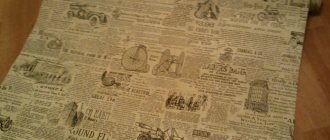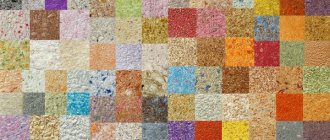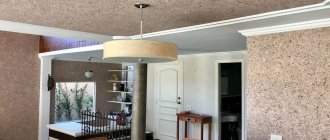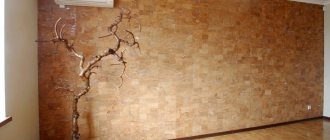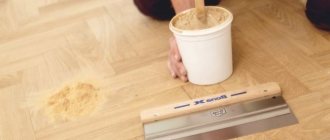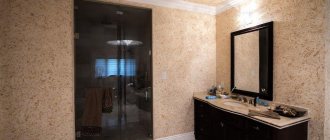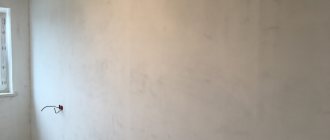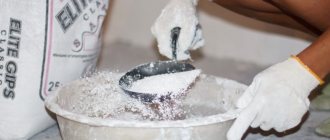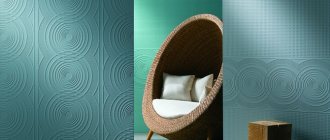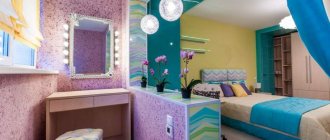As you know, everything new is well forgotten old. So in the first half of the last century, newspapers instead of wallpaper were widespread, because not everyone could afford to buy expensive finishing materials. Later, paper wallpaper ceased to be of any value, but newspapers did not disappear from the walls, but simply “hid” under decorative canvases, as they began to be used as a substrate.
In our time, newspapers are again in the public eye. Of course, now this is not due to a shortage of material and its high cost, but to the desire to decorate the interior in an original and extravagant way. Moreover, in order to decorate a room in this way, it is not even necessary to subscribe to newspapers, since ready-made wallpaper for newspapers has appeared on the market.
Wall covered with newspapers
Next, we will look at the features of this finish and how this coating can be applied to the walls.
Preparation of materials and tools
Making liquid wallpaper with your own hands is quite simple. To work you will need the following components:
- newspapers;
- clean warm water, which will serve as the basis for the future composition;
- tinting pigment for water-based paints (color selected according to individual preferences);
- PVA glue for strength and elasticity of the solution;
- alabaster is predominantly of high quality.
The following tools should be prepared:
- a drill or screwdriver with a special mixer attachment for grinding paper to the desired consistency;
- bucket or other container for solution;
- putty knife.
Reliefs on liquid wallpaper
Liquid wallpaper provides full scope for the implementation of creative ideas. Silk, cotton, and cellulose fibers are added to their composition. The finished mixture only needs to be diluted with water to the desired consistency and applied to the wall. The installation method is similar to plastering. The textures of these surfaces are also similar.
Non-woven wallpaper
If you use a special gun to distribute liquid wallpaper, you can achieve maximum expressiveness of the reliefs. Designer photos of textured wallpaper for walls created using this technology will help you choose the ideal option for your interior.
Liquid wallpaper
These materials have several advantages:
- the ability to create an original design;
- one-piece seamless surface;
- excellent masking of wall defects;
- breathability, sound absorption, protection from cold.
Due to their high strength and resistance to various influences, the coatings retain their aesthetic and functional properties for several years.
Cooking technique
Making liquid wallpaper is a fairly simple task and consists of several stages:
1. You need to take 200 g of paper (the quantity can be calculated depending on the required volume), cut into strips or torn into small pieces, then placed in a bucket and filled with 1.25 liters of warm water.
Related article: Nuances of choosing a laminate to wallpaper color: successful combinations of shades
Paper or newspaper is cut and filled with water
2. To completely soak and soak in water, the composition should be infused for about an hour.
3. Then, using a drill or mixer, the solution must be stirred and crushed until smooth.
Using a mixer, bring to a homogeneous mass.
4. Add 2 caps of paint of the selected color to paint it in the desired tone.
Add paint and glue
5. After that, 20 g of PVA glue is poured into the solution and everything is thoroughly mixed again.
The mixture is thoroughly mixed
6. At the last stage, 200 g of gypsum is added. The material sets quickly, so immediately after this you should begin applying the solution.
Sparkles or colored fibers can also be added to the liquid, which will add even more originality to the finish.
On video: liquid wallpaper from newspapers.
The influence of blue color on humans
Often the walls in a room are finished in blue. This color belongs to the category of cool shades that can very quickly and effectively calm a person. However, a large number of tones allows you to vary the created mood depending on the goals being pursued.
In the office
When choosing blue wallpaper for your home office, it is important to give preference to more saturated shades of this color, but at the same time make sure that it is not too dark and gloomy
It has been proven that deep blue color helps to concentrate on work and not lose sight of important thoughts, which is especially important for people with heavy mental work
However, you should not completely decorate your office in blue. You need to dilute it with several decorative elements in bright colors. This will allow you to relieve the atmosphere and take a break when the need arises.
Child's bedroom
Blue color, as mentioned above, is great at calming. Therefore, if a child is overly active, he can be influenced by a small change of environment.
In this case, you need to use diluted tones of this color, such as cobalt and indigo.
- They are lighter, but at the same time have a positive effect on the psyche of children, forcing them to be less energetic, to make a bias in favor of contemplation and the disclosure of their creative talents.
- Again, you shouldn’t decorate the entire room in blue. A separate corner, for example a work area, should be finished in a slightly different, darker color.
Living room
When decorating a living room, the best option would be to use blue as the main, but not the only, color in the interior. This is due to the fact that it promotes relaxation and, in some cases, concentration.
- And the purpose of the living room lies in pleasant time with family, receiving guests and having a fun holiday.
- That is why it is recommended to glue blue wallpaper in the living room only on one side, often this is the largest wall.
- It is recommended to finish other walls in a different, accompanying color, but it should be more positive.
Or, if you want to make all the walls in the room blue, you need to use bright decorative elements to dilute the atmosphere.
This could be a bright photo frame, bright artificial flowers in a vase, a wall clock, crafts, panels, etc., it all depends on the style in which the living room will be decorated.
Blue wallpaper in the kitchen
Developing an interior design for a kitchen is a particularly challenging task. First of all, because it is necessary to take into account absolutely all the details so that the room is calm, comfortable, and at the same time has sufficient functionality and a sufficient amount of free space.
- Blue color is perfect for kitchen decoration.
- However, most often it is presented in a kitchen version in the form of light vinyl wallpaper of this shade.
- The appearance of the room is complemented by a kitchen set with blue elements.
Light shades of blue will create a calm atmosphere, which is an integral part of a comfortable meal.
How to apply the mixture
The application itself is quite easy and effortless. The pre-cleaned surface must be treated with a primer. Afterwards, the resulting mass is evenly distributed over the surface with a spatula. Complete hardening of the solution occurs after 24 hours.
The process of applying wallpaper from newspapers
Liquid wallpaper for walls is odorless and quite easy to use. In addition, the composition is made from practically harmless and safe for health components.
Examples
To understand what newspaper and wallpaper for walls made from it look like in a finished interior, there is no need to run to the store and look through catalogs - below are several photos of examples of such finishing. After looking through them, you can form your own opinion about such a design and decide whether it is worth experimenting with such decoration in your home.
Wallpaper from newspapers in the interior
Newspaper wallpaper in the interior looks quite original and eccentric. In some cases they look really unusual and beautiful. It is worth considering that the overall design of the room should be in harmony with the chosen solution. Nowadays, there are several stylistic trends that will help make newspapers in the form of wallpaper an excellent addition to the overall range, while making them stand out noticeably.
Modern style
Newspaper and wallpaper do not have to be on all the walls in the room. To achieve the desired effect, it will be enough to decorate one wall with liquid wallpaper, which immediately catches your eye upon entering. In addition, you can add other interior details related to the “newspaper” theme. This could be a table covered with newspapers or other pieces of furniture. You can also make a lampshade for a lamp with your own hands from old waste paper.
Designers advise relying on the play of black and white shades, as a result of which the room will look modern and harmonious. If desired, you can add a few bright accents.
Retro style
Wallpaper in the form of newspapers is most often used in retro style. For the best resemblance, it is recommended to use press from previous times. If there is none, you can find it on the Internet and print it, mainly on newsprint. Quite often in the interior, newspaper wallpaper is used to decorate arches, columns and bay windows.
To get closer to the retro style in the interior, you can add a few things from those times. This could be a vinyl player, a black and white TV and other parts.
Selection of wallpaper design for the bedroom
A bedroom is a kind of temple of relaxation; everything in this room should set us up for relaxation, so it is very important to choose the right design for its interior. All the little things should be thought out here, the furniture should be correctly arranged and all the accents should be correctly placed.
Quite often, bedrooms are decorated in a minimalist style. It implies calm pastel wallpaper and matching furniture. The advantage of this style is that adding just one bright accent can significantly change the mood of the entire room. You can choose white, blue, pink, olive, turquoise or peach wallpaper for such a bedroom.
wallpaper design stylized for black and white bedroom
A bedroom in an oriental style is in many ways similar to a bedroom decorated in a minimalist style. This style implies the absence of unnecessary details in the interior. The color scheme of wallpaper for such a bedroom can range from beige to peach shades.
Wallpaper with various ornaments or patterns can add coziness to your bedroom; by correctly combining them with furniture, you will enjoy the interior around you and a good night's sleep.
wallpaper design in dark colors
Using newspapers under wallpaper
Newspaper wallpaper is a good and justifiable solution. The main advantage is that the paper base does not require putty or primer of the wall. Newsprint paper swells greatly when wet, and after drying completely it stretches and hides many defects in the wall covering. This will save not only time, but also the cost of purchasing material.
Related article: Choosing wallpaper for the living room - fashion trends (+50 photos)
For this case, you can use any whole newspapers with an old or new binder. Pasting occurs in several stages:
1. Removing the old coating and eliminating defects. To achieve an ideal base condition, the surface must be puttied.
2. Applying primer. The composition will improve the adhesion between materials, as well as strengthen the layer of old plaster and act as a barrier against the development of fungus and mold on the walls.
3. The next step is to apply wallpaper glue.
4. Apply newspaper to the area of the wall with glue and gently smooth it out.
5. The next sheet is pasted overlapping in the same way.
6. To consolidate the result, the finished wall with newspapers must be coated with a protective varnish. It is preferable to apply water-based varnish, as it dries quickly and is odorless.
Wallpapering walls with newspaper is quite original and unusual, but it requires a special approach and imagination. The absolute advantage is the minimal cost of the material used, so if the result is not satisfactory, you won’t mind ripping off the finish. To obtain a high-quality coating, it is important to follow all recommendations for preparing and pasting liquid wallpaper from newspapers. Then, in the end, you can get your own quite attractive and sophisticated interior.
Newspapers instead of wallpaper (2 videos)
Options for decorating walls with newspapers (36 photos)
Living room: types of wallpaper
The history of this type of decoration began in China, around the third millennium BC - they began to stick rice paper on the walls. Modern wallpaper for the living room can be either traditional, paper-based, or washable, based on other materials. Based on the base material, they are divided into:
- Paper;
- Vinyl;
- Acrylic;
- Fiberglass;
- Metallized;
- Liquid;
- Natural (textile, bamboo, leather and others).
Each type of wallpaper has its own advantages and disadvantages. Let's take a closer look at them.
Paper
Classic wallpaper for the living room is made on a paper basis. They are not moisture resistant - but in the living room this is usually not required. Caring for such coatings is simple - they need to be cleaned from time to time with a vacuum cleaner. A variety of colors and patterns allows you to choose the right design for any interior, be it classic or modern style. Paper can have different textures, colors, be smooth, textured or embossed.
Vinyl
Interesting designs are created using polymer fibers. Vinyl coverings on a non-woven base have a leveling effect and work as an additional heat and sound insulating layer. Wallpaper design for the living room with silk-screen printing is suitable for classic styles. Silk thread vinyl used as a top layer allows you to create impressive modern wallpaper designs for living rooms.
Acrylic
They have a paper base onto which polymer is applied using a dot method. This gives them a certain advantage over vinyl, as it facilitates air exchange. However, they are less resistant to water and their service life is much shorter. The paper base is not capable of masking wall defects, and the design possibilities are very limited, so this type of coating is not widely used.
Fiberglass
Wallpaper for living room walls made of fiberglass has its advantages: they are very durable and strong, they “breathe” well, and they can be washed. However, the disadvantages are also obvious: there is only one finishing option - painting, and you can repaint it a limited number of times, since the paint gradually hides the relief, worsening the decorative properties. The high cost and complexity of dismantling also do not contribute to the popularity of this coating.
Metallized wallpaper
They can favorably emphasize a design in a high-tech or techno style. Some options are also suitable for classic styles. The basis is non-woven fabric, onto which a thin layer of aluminum foil is applied on top. The foil is embossed or patterned, usually to look like metal: gold, silver, platinum, bronze. The foil has heat-insulating properties, is resistant to moisture, does not fade, and is not subject to wear over time.
Liquid wallpaper
The composition of this finishing material includes cellulose as a base, silk fibers, dyes, decorative components (mica, mother-of-pearl, various minerals in crumbs, glitter, gold and silver threads), as well as substances that protect against mold, rot and binders. In appearance they resemble plaster, are supplied dry and diluted with water before use.
Natural
Wallpaper can be made of fabric, bamboo or jute fibers, or leather sheets. Coatings made from natural fibers applied to non-woven fabric are also called natural. Real dried plants can be woven into these coverings. The original interior design is not the only advantage of this coating. Natural wallpaper has heat-insulating properties, does not fade, and is environmentally friendly.
Pasting newspapers instead of wallpaper
Of course, to decorate a room in this way, the easiest way is to buy ready-made newspaper-style wallpaper. However, as practice shows, they are quite rare on sale, and besides, they do not look so authentic. Therefore, you can use an old newspaper file as wallpaper.
In this case, the instructions for finishing the walls are as follows:
- First of all, as with wallpapering, it is necessary to prepare the base - remove the old coating and eliminate defects. If the base is in poor condition, then the surface must be completely puttied.
- Then the base is treated with a primer for walls. This procedure allows you to improve the adhesion between materials, strengthen old plaster, and also prevent the development of mold, mildew and other microorganisms under the wallpaper. To achieve the best effect, the wall must be primed twice.
- Next, wallpaper glue is applied to the wall.
In the photo - sticking a newspaper on the wall
- Then apply newspaper to the area treated with glue and carefully smooth it with a roller so as not to tear the thin paper.
- The next sheet is glued overlapping in the same way.
- After the walls have dried, the coating should be secured with varnish, otherwise it will be fragile. The varnish is applied in a thin layer using a roller. Depending on the type of composition, the varnish can make the paper yellow or, conversely, make it completely white.
Opening walls with white varnish
This completes the process of gluing the walls. The coating turned out to be durable and monolithic, like real wallpaper. If suddenly the result disappoints you, then it’s not a shame to rip off the finishing, since it required much less investment than repairs using traditional materials.
What kinds of wallpaper are there for walls, where is it best to use them?
Page navigation
In order not to drown in endless wall design options, it is better to start by setting your own priorities. According to the recommendations of experts, before purchasing paintings and repairs, first determine their purpose:
- durability or environmental friendliness;
- originality or budget;
- the need to hide uneven walls or moisture resistance;
- the ability to quickly and easily change the color or a specific design that will become a “feature” in the interior;
- Maybe there are animals in the house and the material needs resistance to mechanical damage.
Once the basic requirements for the material become clear, it will be easier to decide on the types of wallpaper for the walls.
Based on its functionality, structure, thickness and design, the classification is as follows:
- Fabric structure. There is a smooth surface with a relief, embossed with a small pattern, multi-layered.
- Thickness. Thin wallpapers have a low density and, therefore, require perfectly smooth walls. Dense ones are generally less demanding on surface preparation.
- By production design. Plain, patterned, smooth surface, relief, using various materials (usually textile or natural).
- By method of application. In liquid form or in sheets of different sizes.
Moisture resistance of fabrics plays an important role
Moisture resistance deserves special mention:
- Non-moisture resistant ones do not tolerate moisture well. Maintenance is possible only by dry cleaning.
- Moisture-resistant do not deform when treated with a damp sponge, without the use of chemicals.
- Washable ones tolerate moisture well; surfactant-based products can be used for care.
- Highly resistant to water, they can be cleaned not only with household chemicals, but also with a brush.
What types of wallpaper are there based on
In this case, the choice today is huge:
- paper (regular wallpaper);
- vinyl;
- non-woven;
- textile;
- glass wallpaper;
- liquid wallpaper;
- flock;
- velor;
- photo wallpaper;
- acrylic wallpaper;
- metal;
- bamboo.
Each type has its own characteristics, pros and cons. A house or apartment consists of many rooms with their own functionality and corresponding requirements. And by combining these two criteria, it will be easier to choose the appropriate finishing material for each specific zone.
When choosing a paper version, it is worth remembering that this is wallpaper of the most budget class.
Paper wallpapers are made from different types of paper or waste paper. In principle, they can do a good job of masking small unevenness in the walls. They are divided into 2 main groups: simplex (single-layer fabric) and duplex (several layers).
The latter option is considered to be of higher quality and is better suited for external alignment of walls. It is considered an environmentally friendly material.
The designs are varied: embossed, white for painting, a huge selection of designs and patterns. However, paper webs quickly “fail” and lose their presentation due to exposure to sunlight or mechanical damage.
Their use in the bathroom, kitchen and toilet is highly discouraged due to their low resistance to moisture and high ability to absorb odors. Only at first, after using them for a short time, it seems that they managed to improve the interior, but over time comes disappointment and the need for unscheduled repairs.
Vinyl is the most common
Vinyl - those wallpapers that contain paper or non-woven material as a base. The second, top layer is vinyl (or the correct name is polyvinyl chloride). Antifungal drugs may also be added to the composition.
They belong to the class of washable, resistant to dirt and mechanical damage. Structurally, they are divided into 2 main categories: non-embossed and hot embossed.
The latter are divided into 4 main types:
- The embossing is done chemically. The main advantage is resistance to the sun and the ability to use cleaning agents.
- Silkscreen printing. Embossing using high quality acrylic or silk threads. A very popular option, but requires a flat surface.
- Compact vinyl. In appearance it is similar to heavy materials - stone, plaster. The main advantage is resistance to mechanical damage.
- The so-called heavy vinyl. Gained popularity due to its ability to level out significant wall defects.
Vinyl wallpaper can be wet cleaned, it is resistant to mechanical damage and retains its decorative properties for up to 15 years.
The main disadvantage is the flammability of the material. The smoke from them contains chloride compounds. For this reason, they are prohibited in some European countries. Everything you need to know about wallpaper is studied in advance, so that in the store all that remains is to choose the design of the canvases.
Vinyl wallpaper - what you need to know
Thanks to advanced technology, the process of producing vinyl wallpaper has improved and simplified over the years. You can buy wallpaper with any pattern and color.
A correctly selected option for the interior will attract attention and create the character of the room. So it’s worth looking for the right version for yourself.
However, it is important to understand that vinyl wallpaper is not an ideal solution, for example, in the bathroom. This room has the highest humidity, and if the room is poorly ventilated, the vinyl wallpaper may begin to peel off the walls. Foam vinyl wallpaper is not recommended for infants and young children (under 6 years of age).
It is worth noting that, according to some experts, this wallpaper is toxic and harmful to health. These concerns are one of the reasons not to buy them.
Before making a purchasing decision, you need to carefully study the health effects of certain building materials.
Wallpaper for a children's room - interesting solutions
Wallpaper can also be successfully used in children's and teenagers' rooms. Thanks to them, you can create a fresh atmosphere in the room that makes the room suitable for the owner or represents his hobbies and interests. In the case of a children's room, wallpaper often gives the interior a coziness and special warmth that is difficult to achieve with paint.
Wallpaper for the little ones
Wallpaper in a children's room is not only a way to decorate a wall - it is more often used as a decorative accessory that complements the decor of the room and other elements that determine the mood in the room. When choosing wallpaper for a children's room, you should complement it with accessories such as:
- canopy over the crib,
- curtains
- pillows
- carpets.
By completing all these elements in one tone, you will give the interior lightness and softness, and also give a feeling of exceptional comfort.
Wallpaper for a girl's room - not only roses
Wallpaper for a girl's room does not necessarily mean expressive shades of pink. Let's make sure that the decor in the room is not obvious, because it will quickly get boring. It is much better to fill the room with atmospheric accents in the form of:
- curtains,
- lamps
- carpets,
- images.
Wallpaper for a girl's room should be neutral in color, matching the above elements. They can be pastel colors, but in the room they should be gentle and unobtrusive. If you decide on a more expressive pattern, let it be visible on only one wall. This way you will avoid the impression of clutter and overwhelming effect.
Lately, dots have become a very popular topic, which can be represented by wallpaper in a girl’s room. This is one of the patterns that is relatively easy to match with other accessories, and at the same time, it is a classic and fashionable theme.
If you want to decorate a universal room in which both a boy and a girl will live, turquoise wallpaper will be a good choice. This shade harmonizes well with many colors of accessories, so with its help it is very easy to distinguish between zones in the room - separate ones for girls and boys.
Wallpaper for a boy's room - what to choose?
Wallpaper for a boy's room should also have the same features as wallpaper for a girl's room. When choosing wallpaper, you should focus on less obvious motifs or limit yourself to only one wall. For example, decorating a wall with a three-year-old boy’s favorite fairy tale characters means that the room will almost certainly get boring very quickly and the child will “grow out of it.” After a short time, you will have to change the design, which entails additional costs and time.
A much better solution would be to use classic wallpaper designs or designs with a more universal theme:
- cars,
- animals
- colorful illustrations.
Thanks to this, we are sure that the room will suit even older boys, and by changing only the accessories in the room, you can easily change the layout and refresh the interior.
Stripes are an example of a classic pattern that would be perfect as wallpaper for a boy's room. In this case, you should rely on brightly colored stripes and choose accessories of a suitable shade. Thanks to this, you will get an interior in which it is interesting, fun and enjoyable to spend your free time.
Wallpaper for a wall can have many different designs. This:
- geometric motifs,
- graphic arts,
- flowers,
- art paintings,
- photo,
- cards.
- and many others.
The choice of wallpaper pattern and color should be determined by personal preferences and the character of the household, as well as the desired effect. If you want to emphasize the owner’s crazy temperament, choose bright, colorful wallpaper that will match his spontaneity. When you want to emphasize a romantic character or sensitivity, it is better to choose delicate floral motifs or geometric patterns. Please note that some people spend most of their time in their rooms. Choosing the right wallpaper can be difficult. It is especially difficult to adapt them to an already furnished room, where the prevailing interior and visible accessories must be taken into account. By following a few basic rules and universal tips, you are sure to choose a color and pattern that will become an interesting decoration and make the room stylish and fashionable.
Choosing the right wallpaper can be difficult. It is especially difficult to adapt them to an already furnished room, where the prevailing interior and visible accessories must be taken into account. By following a few basic rules and universal tips, you are sure to choose a color and pattern that will become an interesting decoration and make the room stylish and fashionable.
How to properly glue vinyl wallpaper
Proper wallpapering plays an important role. In case of sloppy, careless placement of vinyl wallpaper, the interior of the room will become extremely unsightly, and the image of it will be spoiled.
Before wallpapering, the wall should be cleaned. Previous wallpaper or newspapers must be removed.
Before you completely glue the wallpaper, you need to evenly adhere it to the wall. When cutting wallpaper into pieces, you should be careful and check where the patterns intersect. Everything should look perfect.
Advantages of vinyl wallpaper
- Vinyl wallpaper is extremely durable, scratch-resistant and very easy to clean;
- The biggest advantage of this type of cladding is the ability to wet remove dirt without fear of possible damage to the pattern;
- They are resistant to moisture;
- They are easy to wash;
- They are resistant to sunlight, so they can remain in perfect condition for a long time.
